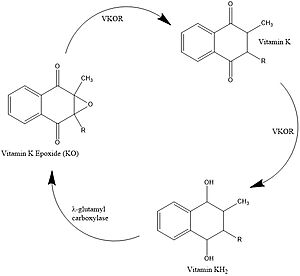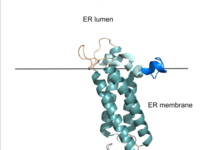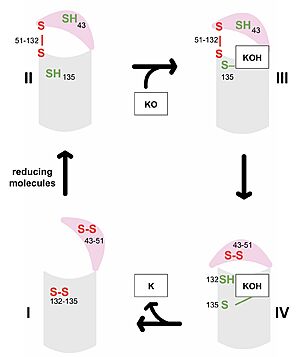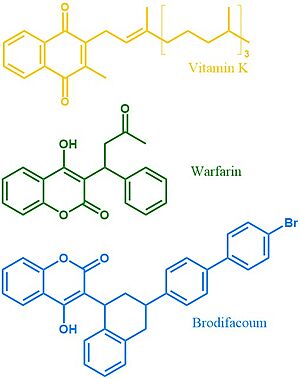Sandbox Reserved 1724
From Proteopedia
(Difference between revisions)
| Line 5: | Line 5: | ||
== Introduction == | == Introduction == | ||
Vitamin K epoxide reductase (VKOR) is the enzyme responsible for regenerating vitamin K from vitamin K epoxide to support blood coagulation. | Vitamin K epoxide reductase (VKOR) is the enzyme responsible for regenerating vitamin K from vitamin K epoxide to support blood coagulation. | ||
| - | [[Image:Vitamin_K_Cycle_IJEV.jpg|300 px|left|thumb|Figure 1. Vitamin K Cycle]] | + | [[Image:Vitamin_K_Cycle_IJEV.jpg|300 px|left|thumb|'''Figure 1. Vitamin K Cycle''' λ-glutamyl carboxylase uses Vitamin KH2 to carboxylate blood clotting cofactors, converting KH2 to KO in the process. Prothrombin is shown as an example of a blood clotting cofactor that later enters the coagulation cascade. VKOR converts KO back to KH2 via two steps with Vitamin K as an intermediate. ]] |
| + | |||
=== Vitamin K Cycle === | === Vitamin K Cycle === | ||
| - | [https://en.wikipedia.org/wiki/Vitamin_K Vitamin K] is essential for blood clotting in the body. The fully reduced form, KH2, | + | [https://en.wikipedia.org/wiki/Vitamin_K Vitamin K] is essential for [https://en.wikipedia.org/wiki/Coagulation#Coagulation_cascade blood clotting] in the body<ref name="Stafford">PMID:16102054</ref>. The fully reduced form, KH2, is used by [https://en.wikipedia.org/wiki/Gamma-glutamyl_carboxylase#:~:text=Gamma-glutamyl%20carboxylase%20is%20an%20enzyme%20that%20catalyzes%20the,of%20the%20encoded%20enzyme%20is%20essential%20for%20hemostasis gamma-glutamyl carboxylase] to carboxylate protein-bound glutamate residues in blood clotting cofactor precursors <ref name="Blanchard">PMID:6165889</ref>. After carboxylation, the clotting cofactors (such as [https://proteopedia.org/wiki/index.php/Thrombin prothrombin]) can bind to calcium and can proceed to the coagulation cascade <ref name="Swanson">PMID:6758841</ref>. During this process, KH2 becomes oxidized to Vitamin K epoxide, or KO <ref name="Blanchard">PMID:6165889</ref>. Vitamin K epoxide reductase, abbreviated VKOR, turns the epoxide back to the fully reduced form so the reduced form can be used again. This transformation happens in two steps: 1) converting the epoxide to the partially oxidized Vitamin K quinone and 2) converting the quinone to the fully reduced hydroquinone (KH2) (Figure 1) <ref name="Stafford">PMID:16102054</ref>. |
| + | |||
| + | [[Image:vkor_crop.png|200 px|right|thumb|'''Figure 2. VKOR in Membrane''' The teal helices are the transmembrane helices. The tan sections are the beta loop and cap loop. The light blue section is the cap helix, and the dark blue section is the anchor. The cap loop, cap helix, and anchor make up the cap domain.]] | ||
| - | [[Image:barrel_domain_smaller.jpg|200 px|right|thumb|Figure 2. VKOR with Barrel Domain]] | ||
=== Structural Overview === | === Structural Overview === | ||
| - | VKOR consists of four <scene name='90/904330/Transmembranehelices1/1'>transmembrane helices</scene> embedded in the endoplasmic reticulum membrane. The | + | VKOR consists of four <scene name='90/904330/Transmembranehelices1/1'>transmembrane helices</scene> embedded in the endoplasmic reticulum membrane. The barrel domain was used experimentally to stabilize VKOR for structure determination (Figure 2)<ref name="Liu">PMID:33154105</ref>. For this page, the barrel domain has been removed and structures renumbered to correspond with the article by Liu. <ref name="Liu">PMID:33154105</ref>. Helices one and two are connected by the <scene name='90/904330/Betahairpin2/1'>beta hairpin</scene> region which contains two of the active cysteines, C43 and C51; these cysteines, along with C132 and C135, are essential for reduction and structural changes discussed in the next section<ref name="Liu">PMID:33154105</ref>. VKOR also has a <scene name='90/904330/Capdomain/1'>cap domain</scene> covering the active site, made up of an <scene name='90/904330/Capanchor/1'>anchor</scene>, <scene name='90/904330/Caploop/1'>loop</scene>, and <scene name='90/904330/Caphelix/1'>helix</scene>. The anchor serves to attach the cap domain to the ER membrane for stabilization<ref name="Liu">PMID:33154105</ref>. The loop helps stabilize one of the catalytic amino acids, Asn80<ref name="Liu">PMID:33154105</ref>. The helix is involved in stabilization of certain disulfide bonds and structural changes as part of the catalytic cycle discussed below<ref name="Liu">PMID:33154105</ref>. |
=== Active Site === | === Active Site === | ||
| Line 29: | Line 31: | ||
===Warfarin=== | ===Warfarin=== | ||
| - | Warfarin is the most widely prescribed oral anticoagulant and targets blood clotting via inhibition of vitamin K epoxide reductase. The FDA approved uses for cardiac conditions (myocardial infarction, atrial fibrillation) as well as for deep vein thrombosis and pulmonary embolism. Due to the inhibition of the normal blood clotting cycle, patients taking warfarin are at risk for hemorrhage which can occur anywhere in the body. <ref name="Patel">PMID:29261922</ref> | + | [https://en.wikipedia.org/wiki/Warfarin Warfarin] is the most widely prescribed oral anticoagulant and targets blood clotting via inhibition of vitamin K epoxide reductase. The FDA approved uses for cardiac conditions (myocardial infarction, atrial fibrillation) as well as for deep vein thrombosis and pulmonary embolism. Due to the inhibition of the normal blood clotting cycle, patients taking warfarin are at risk for hemorrhage which can occur anywhere in the body. <ref name="Patel">PMID:29261922</ref> |
| + | |||
| + | Warfarin is a <scene name='90/904330/Bothsubstratevkor/2'>structural mimic</scene> of Vitamin K that occupies the VKOR binding site, acting as a competitive inhibitor. Warfarin binding also depends on the VKOR catalytic cysteines. Warfarin is able to bind to the fully oxidized open form of VKOR as shown in <scene name='90/904329/Cat_cycle_i/1'>step I</scene> of the catalytic cycle. Once Warfarin binds, VKOR is considered to be in a closed conformation since the substrate cannot enter, despite the lack of disulfide bridge changes. Warfarin can also bind to the partially oxidized form of VKOR as shown in <scene name='90/904329/Cat_cycle_2/1'>step II</scene> of the catalytic cycle. | ||
| - | + | There are around 30 known missense mutations that lead to warfarin resistance in patients, but these mutations do not affect Vitamin K binding for reasons which are not yet fully understood. Such patients require higher doses of warfarin to reach therapeutic level or require a different anticoagulant drug. <ref name="Wu">PMID:29743176</ref> | |
==== Warfarin Dependence on Catalytic Cysteines ==== | ==== Warfarin Dependence on Catalytic Cysteines ==== | ||
| Line 37: | Line 41: | ||
===Superwarfarins=== | ===Superwarfarins=== | ||
| - | [[Image: | + | [[Image:VKOR_Substrates.jpg|300 px|right|thumb|'''Figure 4. Vitamin K, Warfarin, and Brodifacoum''' Above is a comparison of the 2D structures of VKOR's natural substrate, the blood thinner warfarin, and the superwarfarin brodifacoum.]] |
| - | More potent warfarin derivatives, called superwarfarins, are used as rodenticides. Superwarfarins have bulkier side chains that allow them to stay bound to VKOR for long periods of time, causing prolonged and uncontrolled bleeding. The duration of one superwarfarin, brodifacoum, has been reported as 15-30 days <ref name="Chong">PMID:31857739</ref> vs. the clinical warfarin duration of 2-5 days<ref name="Patel">PMID:29261922</ref>. | + | More potent warfarin derivatives, called [https://en.wikipedia.org/wiki/Superwarfarin superwarfarins], are used as rodenticides. Superwarfarins have bulkier side chains that allow them to stay bound to VKOR for long periods of time, causing prolonged and uncontrolled bleeding<ref name="Chong">PMID:31857739</ref>. The enhanced binding is due to interactions between the bulky side chains and the hydrophobic residues of VKOR's binding pocket. The duration of one superwarfarin, [https://en.wikipedia.org/wiki/Brodifacoum brodifacoum], has been reported as 15-30 days <ref name="Chong">PMID:31857739</ref> vs. the clinical warfarin duration of 2-5 days<ref name="Patel">PMID:29261922</ref>. |
</StructureSection> | </StructureSection> | ||
Revision as of 17:36, 14 April 2022
–
| This Sandbox is Reserved from February 28 through September 1, 2022 for use in the course CH462 Biochemistry II taught by R. Jeremy Johnson at the Butler University, Indianapolis, USA. This reservation includes Sandbox Reserved 1700 through Sandbox Reserved 1729. |
To get started:
More help: Help:Editing |
Vitamin K Epoxide Reductase
| |||||||||||
References
- ↑ 1.0 1.1 Stafford DW. The vitamin K cycle. J Thromb Haemost. 2005 Aug;3(8):1873-8. doi: 10.1111/j.1538-7836.2005.01419.x. PMID:16102054 doi:http://dx.doi.org/10.1111/j.1538-7836.2005.01419.x
- ↑ 2.0 2.1 Blanchard RA, Furie BC, Jorgensen M, Kruger SF, Furie B. Acquired vitamin K-dependent carboxylation deficiency in liver disease. N Engl J Med. 1981 Jul 30;305(5):242-8. doi: 10.1056/NEJM198107303050502. PMID:6165889 doi:http://dx.doi.org/10.1056/NEJM198107303050502
- ↑ Swanson JC, Suttie JW. Vitamin K dependent in vitro production of prothrombin. Biochemistry. 1982 Nov 9;21(23):6011-8. doi: 10.1021/bi00266a044. PMID:6758841 doi:http://dx.doi.org/10.1021/bi00266a044
- ↑ 4.00 4.01 4.02 4.03 4.04 4.05 4.06 4.07 4.08 4.09 4.10 4.11 Liu S, Li S, Shen G, Sukumar N, Krezel AM, Li W. Structural basis of antagonizing the vitamin K catalytic cycle for anticoagulation. Science. 2020 Nov 5. pii: science.abc5667. doi: 10.1126/science.abc5667. PMID:33154105 doi:http://dx.doi.org/10.1126/science.abc5667
- ↑ 5.0 5.1 Patel S, Singh R, Preuss CV, Patel N. Warfarin PMID:29261922
- ↑ Wu S, Chen X, Jin DY, Stafford DW, Pedersen LG, Tie JK. Warfarin and vitamin K epoxide reductase: a molecular accounting for observed inhibition. Blood. 2018 Aug 9;132(6):647-657. doi: 10.1182/blood-2018-01-830901. Epub 2018, May 9. PMID:29743176 doi:http://dx.doi.org/10.1182/blood-2018-01-830901
- ↑ 7.0 7.1 Chong YK, Mak TW. Superwarfarin (Long-Acting Anticoagulant Rodenticides) Poisoning: from Pathophysiology to Laboratory-Guided Clinical Management. Clin Biochem Rev. 2019 Nov;40(4):175-185. doi: 10.33176/AACB-19-00029. PMID:31857739 doi:http://dx.doi.org/10.33176/AACB-19-00029
Student Contributors
Izabella Jordan, Emma Varness




